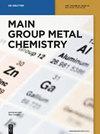1,4-环己烷二羧酸与菲咯啉衍生物的新型镉(Ⅱ)配位聚合物的合成与晶体结构
IF 1.2
3区 化学
Q3 CHEMISTRY, INORGANIC & NUCLEAR
引用次数: 2
摘要
摘要在水热条件下,用L配体和1,4-H2chdc酸成功合成了一种新的Cd(ii)配位聚合物[Cd(1,4-chdc)(L)]n(1)(L=1-(1H-咪唑并[4,5-f][1,10]菲咯啉-2-基)萘-2-醇配体和1,4-H2chdc=1,4-环己烷二羧酸),以及红外光谱。每个Cd(ii)原子都是扭曲的五角双锥几何结构,连接去质子化的1,4-chdc阴离子形成2D层,并且通过相邻层之间的π–π堆叠相互作用,2D层形成3D超分子结构。本文章由计算机程序翻译,如有差异,请以英文原文为准。
A new cadmium(ii) coordination polymer with 1,4-cyclohexanedicarboxylate acid and phenanthroline derivate: Synthesis and crystal structure
Abstract A new Cd(ii) coordination polymers, formulated as [Cd(1,4-chdc)(L)] n (1) (L = 1-(1H-imidazo[4,5-f][1,10]phenanthrolin-2-yl)naphthalen-2-ol ligands and 1,4-H2chdc = 1,4-cyclohexanedicarboxylate acid), were successfully synthesized by using L ligand and 1,4-H2chdc acid under hydrothermal conditions and characterized by single crystal X-ray elemental analyses, diffraction, and IR spectroscopy. Each Cd(ii) atom is a distorted pentagonal bipyramidal geometry connecting the deprotonated 1,4-chdc anion to form a 2D layer, and a 2D layer is formed into a 3D supramolecular structure by the π–π stacking interactions between neighboring layers.
求助全文
通过发布文献求助,成功后即可免费获取论文全文。
去求助
来源期刊

Main Group Metal Chemistry
CHEMISTRY, INORGANIC & NUCLEAR-CHEMISTRY, ORGANIC
CiteScore
4.10
自引率
27.80%
发文量
21
审稿时长
4 weeks
期刊介绍:
This journal is committed to the publication of short communications, original research, and review articles within the field of main group metal and semi-metal chemistry, Main Group Metal Chemistry is an open-access, peer-reviewed journal that publishes in ongoing way. Papers addressing the theoretical, spectroscopic, mechanistic and synthetic aspects of inorganic, coordination and organometallic main group metal and semi-metal compounds, including zinc, cadmium and mercury are welcome. The journal also publishes studies relating to environmental aspects of these metals, their toxicology, release pathways and fate. Articles on the applications of main group metal chemistry, including in the fields of polymer chemistry, agriculture, electronics and catalysis, are also accepted.
 求助内容:
求助内容: 应助结果提醒方式:
应助结果提醒方式:


